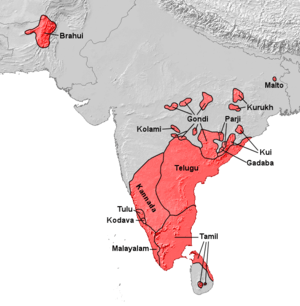Proto-Dravidian language
| Proto-Dravidian | |||||||||||||||||||||||||
| Proto-South-Dravidian | Proto-South-Central Dravidian | ||||||||||||||||||||||||
| Proto-Tamil-Kannada | Proto-Telugu | ||||||||||||||||||||||||
| Proto-Tamil-Toda | Proto-Kannada | Proto-Telugu | |||||||||||||||||||||||
| Proto-Tamil-Kodagu | Kannada | Telugu | |||||||||||||||||||||||
| Proto-Tamil-Malayalam | |||||||||||||||||||||||||
| Proto-Tamil | Malayalam | ||||||||||||||||||||||||
| Tamil | |||||||||||||||||||||||||
| Part of a series on |
| Dravidian culture and history |
|---|
 |
|
History
|
|
Culture
|
|
Language
|
|
Religion
|
|
Regions
|
|
People
|
| Portal:Dravidian civilizations |
Proto-Dravidian is the comparative grammar assumption term suggested by some research scholars. They assumed there was one proto-language for all of the Dravidian languages.[1] It is thought to have differentiated into Proto-North Dravidian, Proto-Central Dravidian and Proto-South Dravidian[2] around 500 BC, although some linguists have argued that the degree of differentiation between the sub-families points to an earlier split.
As a proto-language, Proto-Dravidian has been reconstructed and is not itself found in the historical record. Due to a dearth of comparative linguistic research in Dravidian studies, not many details as to the grammar, epoch, or location of Proto-Dravidian are known.[3]
Reconstructed language
Historical phonology
Vowels: Proto-Dravidian contrasted between five short and long vowels: *a, *ā, *i, *ī, *u, *ū, *e, *ē, *o, *ō. The sequences *ai and *au are treated as *ay and *av (or *aw)[4]
Consonants: Proto-Dravidian is reconstructible with the following consonantal phonemes (Subrahmanyam 1983:p40, Zvelebil 1990, Krishnamurthi 2003):
| Labial | Dental | Alveolar | Retroflex | Palatal | Velar | Glottal | |
|---|---|---|---|---|---|---|---|
| Nasal | *m | *n | *ṉ | *ṇ | *ñ | (*ṅ) | |
| Plosive | *p | *t | *ṯ | *ṭ | *c | *k | |
| Fricative | *ḻ (*ṛ, *r̤) | (*h) | |||||
| Flap | *r | ||||||
| Approximant | *v | *l | *ḷ | *y |
The alveolar stop *ṯ in many daughter languages developed into an alveolar trill /r/. The stop sound is retained in Kota and Toda (Subrahmanyam 1983). Malayalam still retains the original (alveolar) stop sound in gemination. (ibid). In Old Tamil it took the enunciative vowel like the other stops. In other words, *ṯ (or *ṟ) did not occur word-finally without the enunciative vowel (ibid).
Velar nasal *ṅ occurred only before *k in Proto-Dravidian (as in many of its daughter languages). Therefore it is not considered a separate phoneme in Proto-Dravidian. However, it attained phonemic status in languages like Malayalam, Gondi, Konda and Pengo due to the simplification of the original sequence *ṅk to *ṅ. (Subrahmanyam 1983)
The glottal fricative *h has been proposed by Bh. Krishnamurthi to account for the Old Tamil Aytam (Āytam) and other Dravidian comparative phonological phenomena (Krishnamurthi 2003).
Notes
- ↑ http://books.google.co.in/books?id=vhB60gYvnLgC&pg=PA299&dq=proto-dravidian&hl=en&sa=X&ei=blfFU9GcK9aVuATn1ICwBQ&ved=0CBoQ6AEwAA#v=onepage&q=proto-dravidian&f=false
- ↑ http://books.google.co.in/books?id=54fV7Lwu3fMC&pg=PA492&dq=Proto+south+dravidian&hl=en&sa=X&ei=XFnFU-LaKdacugTosIGACQ&ved=0CBoQ6AEwAA#v=onepage&q=Proto%20south%20dravidian&f=false
- ↑ "Facts about Dravidian languages". The Hindu (Chennai, India)., review of The Dravidian Languages by Bhadriraju Krishnamurti; Cambridge University Press, Cambridge (South Asian edition), 2003.
- ↑ Baldi, Philip (1990). Linguistic Change and Reconstruction Methodology. Walter de Gruyter. p. 342. ISBN 3-11-011908-0.
See also
References
- Krishnamurti, B., The Dravidian Languages, Cambridge University Press, 2003. ISBN 0-521-77111-0
- Subrahmanyam, P.S., Dravidian Comparative Phonology, Annamalai University, 1983.
- Zvelebil, Kamil., Dravidian Linguistics: An Introduction", PILC (Pondicherry Institute of Linguistics and Culture), 1990
External links
T. Burrow (1984). Dravidian Etymological Dictionary, 2nd Edition. Oxford: Oxford University Press. ISBN 978-0-19-864326-5. Retrieved 2008-10-26.
| ||||||||||||||||||||||||||||||||||||||||||||||||||||||||||||||||||